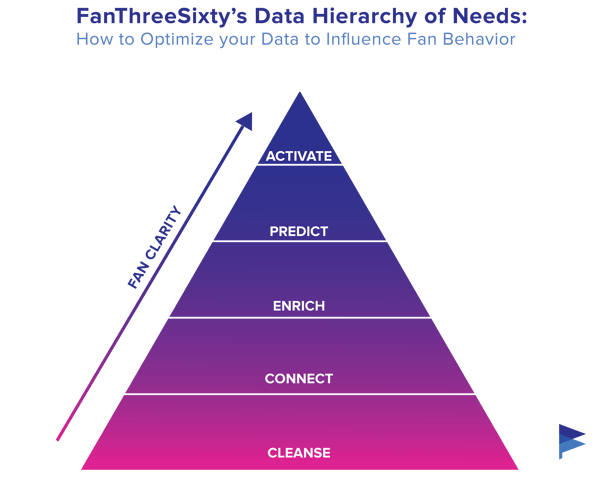Technology and digital media have fundamentally transformed the way fans watch and attend sports events. From streaming content, team apps and digital tickets to eCommerce and in-venue Wi-Fi, fans today are more digitally connected than ever before. And while this has led to a deeper connection between fans and their favorite teams, it has also created an explosion of valuable fan information. This data, ranging from demographic and behavioral to social data, gives teams a more progressive and accurate way to understand their fans. From this, teams can better predict the movements and needs of their fans, down to the individual, letting them surprise and delight their fans with remarkable experiences. In short, using what you know about fans in order to predict what they want next to serve them this at the right moment.
But delivering this type of personalized fan experience requires a clear data strategy and taking a number of foundational steps to ensure this can be seamlessly delivered to all fans (fig. 1).

Figure 1: FanThreeSixty's Data Hierarchy of Needs
At FanThreeSixty, we’ve built an integrated fan engagement platform-as-a-service to do this for you by consolidating, cleaning and centralizing fan data from disparate sources so teams can gain a Single Fan View, leading to actionable insights.
Data: Knowing What Matters
Our experience with tens of millions of fan records demonstrates the need for five essential data elements to capture from fans: ZIP code; email address; phone number; first name; and last name. These are the puzzle pieces to a fan’s identity, and when assembled, become the data to fuel your fan experiences. Here’s why each one of these serves as a cornerstone to building a consolidated, enriched fan profile from which predictive analytics can be created.
ZIP Code Data
There are more than 42,000 ZIP Codes in the U.S. and there is likely more than one person in the same ZIP Code with the same name. But when combined with demographic data, like birthday and gender, postal codes provide enough information to identify an individual fan who lives in New York by name. Using a blend of statistical analysis and data science, key demographic data can be appended to a fan’s profile from ZIP Code alone. Together, it can reveal a person’s age, gender, income, race, household size, education level and occupation, giving a team clarity about their existing fans and the knowledge to grow its fan base.
ZIP Codes also reveal distance to venue, and this small insight can yield big returns for the ticketing office. Distance to venue and household income are the two strongest drivers of who is most likely to attend a game and who is most likely to purchase season tickets. In fact, fan insights gleaned from FanThreeSixty’s proprietary Fan Engagement Platform show over half of season ticket members live within 16 miles of the team’s stadium and over 90 percent live within 25 miles.
From ZIP Codes, fans can also be assigned to specific Designated Market Areas (DMA). Sometimes referred to as media market or broadcast market, DMA matters in sports, particularly for sponsorship and broadcast rights. Once fans are assigned to DMAs, teams can glean insights to help their sponsors better reach their target audience with the right message at the right time to drive brand loyalty.
Email Address
An email address is central to one’s digital life, making it a critical data element for any modern day marketer. Aside from using an email address to contact fans, it can provide insight into who is buying tickets versus those who are actually using the tickets. And in order to receive transferred tickets on the secondary market, a valid email address must be used. This not only gives teams accurate email information, but it also provides clarity about who is really in the venue.
But ticketing alone does not guarantee a verified email address for every fan in a team’s database. So teams should use other touch points to collect this information from their fans. In-venue Wi-Fi is a great way to gather this data. Offer an incentive to fans in exchange for sharing their email address as part of the registration process. Teams can even ask a few targeted questions as they register, gathering preferential data to append to their profile while collecting their email address. This leads to verified attendance, providing teams with accurate insights about who was in the venue and at what time fans entered.
And if a team owns its own mobile app, it can capture a fan’s email address as part of the registration process. Once registered, the app is then transformed into a data engine, constantly collecting behavioral, demographic and preferential data about fans right from the app. This information is appended to the fan’s profile, letting teams understand where, when and how their fans prefer to interact with their team.
Phone Numbers
While it may seem like phone calls are dead, a fan’s phone number is relevant and critical data for a team. Teams can use a number to launch targeted text campaigns, which will likely drive better engagement as over 90 percent of texts are read within two minutes. Additionally, there is a low probability that a fan has more than one phone number, making it an accurate source for contact information. And when combining demographic data, like ZIP Code, with phone number, a team can contact a fan faster by phone to offer those fans who live nearby last minute ticket offers. This becomes particularly useful for weeknight games with maybe lower-than-average ticket sales or those games with at-risk attendance due to weather.
First and Last Name
What’s in a name? While this famous quote from Shakespeare’s Romeo and Juliet implied that a name meant little, names actually do matter. A fan’s name is the most basic piece of data that can help create personalized experiences. And now that over 70 percent of consumers expect a personalized experience (source: linkdex), first and last names are critical data elements for sports teams.
A fan’s first name alone can help predict gender for over 90 percent of fans with about 90 percent accuracy. Last name can lead to a prediction of ethnicity, which is important information to leverage when segmenting fans into distinct audiences. It’s a simple piece of information that can have a big impact. As Dale Carnegie said in How to Win Friends and Influence People, “Names are the sweetest and most important sound in any language.” Using a fan’s name shows a heightened level of care and customer service—two factors to building a remarkable experience. It may seem small, but tiny details add up.
So What’s Next?
The future of fan engagement, fueled by artificial intelligence and machine learning, starts with having the right data about your fans. From this, teams can gain a consolidated fan view and a method to capture and append behavioral data in near real-time. This results in data-led activations that continuously capture new information about fans, helping better predict each fan’s distinct needs. And this is where the real surprise and delight comes to life. By knowing what fans want and when they want it before they do, and capturing them when it matters most, is the true magic of sports today.
Stay tuned for our next feature, Data Hygiene: Your Cleaning Checklist. You wouldn’t drink spoiled milk; so, why would you use outdated data? Subscribe to our blog to receive an alert when this article is live.

